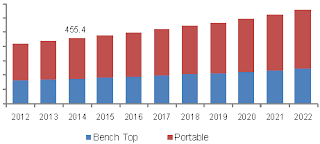The global in-vitro toxicology testing market is expected to reach USD 44.7 billion by 2022 growing at an estimated CAGR of 10.5% from 2015 to 2022, according to a new report by Grand View Research, Inc. This expected rise in demand can be ascribed to novel and promising technologies in analytical laboratories.
Advancement in bioinformatics based research for development of efficient software algorithms in order to carry out efficient stimulation of in-silico animal models in determination of toxicological response is expected to influence sector growth through to 2022.
Furthermore, rapid up gradation of databases that serve information for toxicity profiling and lethal dose determination of different compounds is anticipated to create significant potential for growth in this market during the forecast period.
Rise in government imposed restrictions and guidelines on usage of animals for pre-clinical research and toxicology testing is also attributive towards estimated progress in this industry.
Additionally, increasing R&D in biotechnology sector for enhancement in cell based assays and cell culture techniques, is anticipated to impart significant growth potential in this sector.
North America In-vitro Toxicology Testing Market, By Technology 2012-2022 (USD Million)
View summary of "In-vitro Toxicology Testing Market Analysis Report"
Further key findings from the study suggest:
- Pharmaceutical and cosmetic industry together accounted for almost 65% of total revenue generated in this sector for 2014. This large share can be attributed to rapid novel product launches for treatment of different diseased conditions wherein toxicological testing is the pre-requisite step.
- Cell culture technology contributed for over 42% of the revenue generated in the industry with respect to technology owing to critical role of cell culture in biotechnological development and cell based analysis
- Omics technology is anticipated to register lucrative growth thereby driving demand due to advancement in sequencing methods and availability of different platforms depending on source and target sequence.
- As a fundamental process in biopharmaceutical or pharmaceutical product development toxicological testing finds application in determination of systemic, dermal, & ocular toxicity as well as endocrine disruption
- Amongst the above enlisted applications, dermal toxicity is expected to witness significant progress with a CAGR of approximately 13% due to comparatively higher incidence of side effects associated with skin after administration of several compounds.
- North America accounted for the largest share of over 45% in revenue in 2014 owing to presence of significant number of sector players that are implementing advanced in-vitro technology. Furthermore, presence of stringent regulations pertaining to animal usage in toxicity analysis attributive towards high demand of in-vitro tests in this region.
- Asia Pacific is expected to witness lucrative CAGR of over 11% from 2015 to 2022 due to rapid improvement in health care infrastructure in developing economies of this region which in turn contributes to regional progress in industry.
- Key participants of in-vitro toxicology testing industry are Quest Diagnostics, Covance, Cyprotex, Alere, Inc, Charles River Laboratories, GE Healthcare, Thermo Fisher Scientific, Eurofins Scientific, Inc., Agilent Technologies, Catalent Pharma Solutions, Sigma Aldrich, and Bio-Rad.
- These participants are involved in collaborations with bioinformatics research firms in order to develop novel in-silico algorithms for computational estimation of toxicity of pharmaceutical and chemical products.
- Moreover, these market entities are also focusing on entering untapped regions in order to maintain their share in market revenue.
Request for free sample of "In-vitro Toxicology Testing Market Analysis Report"



